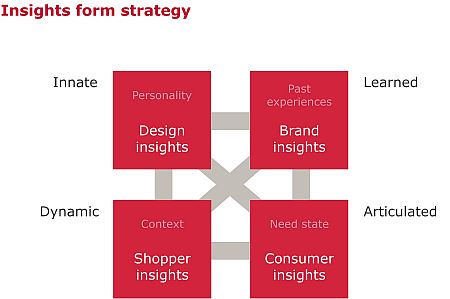![]()
You are welcome to share your thoughts on this article written by Fred Richards, Global Executive Director for Consumer Packaged Goods Executive Creative Director, North America, Interbrand
Quick! Your brand has just 20 feet and five seconds to attract a consumer’s attention at shelf and spur a purchase. Brands create consumer pull; however, the psychology of brand purchase decisions is far more instinctive than rational. In fact, just five percent of purchases are based on a rational, articulated decision; 95 percent are based on an unconscious decision; on emotions rather than logic.
By understanding, leveraging and connecting shopper, consumer, brand and design insights, companies can develop powerful, instinctive packaging designs that connect with key emotions and produce as much as an 80 percent conversion rate (Figure 1).
Instinctive Design Elements
Using certain design elements and techniques can make your brand’s packaging more powerful …and help it instinctively delight shoppers and consumers. Among these are:
• Shape and color — The ability of humans as a species to make consistently good — and safe — choices among the millions of items in their environment is due, in large measure, to the harmony of shape and color. The combination of the two in logos, product packaging and in-store signage determines how quickly — and positively — a consumer processes a brand’s visual message and aids in the selection of one brand over another.
• Creating characters — For brands operating in child-focused categories such as restaurants, cereal, bath items, snack foods or similar, featuring licensed/cartoon characters on product packaging can cause media-savvy children (and their “gatekeeper” parents) to flock to their favorite brands like birds to a feeder. One caution: Certain characters and themes are definitely age-related; one day Dora the Explorer is all the rage and the next birthday it’s a bad case of Bieber Fever.
• Location — Using images of far-off destinations on product packaging can help consumers associate that product or brand with a specific culture or geographic location. This very effective design methodology, sometimes referred to as “postcard concepting,” can evoke the smells, textures and sounds of a happy vacation or longed-for getaway and forge an emotional connection with the product’s purchaser.
• Playing with numbers — Numbers can dictate, guide, rule, inform or justify the world around us. For male consumers, numbers such as batting average, car speeds or whiskey ages provide an opportunity to claim bragging rights as part of the bonding ritual among friends. Numbers also can convey wealth and status (e.g., Chanel No. 5, BMW 3.5), and be a powerful way to validate a brand’s heritage claims: the older the date, the greater the chance that consumers will instinctively acknowledge that it must be doing something right.
• Appetite Appeal — “Tasteful” food photography and illustrations can help to create a package design that communicates high-quality ingredients, conveys ease of preparation, and elevates a product’s taste appeal — all of which satisfy consumers’ instinctual desire to feed their family a nutritious meal.
• Patterns and textures — For centuries, tribes have used patterns and textures to identify and differentiate themselves, signal “I belong” to a particular group, and find and recognize friends. Today’s brands can use a distinctive pattern or texture in their product packaging as a way to build valuable brand equity in simple visual elements, generate instant consumer recognition and cut through the on-shelf clutter.
• Opening ceremonies — Celebrating a package’s opening is a precious consumer connection with a brand, an emotional moment akin to opening a gift each and every time. Certain ceremonies can even become so ritualistic in terms of usage that opening the package becomes an inherent part of the brand experience (e.g., Nivea’s foil inner wrap, Altoids’ crinkly protective paper). The opening ceremony is one of the few occasions that a brand has to engage all of a consumer’s senses when he or she has the product in hand; as such, it can generate a powerful, instinctual connection — over and over again.
Which of these Instinctive Design levers will you pull tomorrow to ensure that your brand’s packaging forges compelling connections with consumers?
About the Author
Fred Richards is Global Executive Creative Director at Interbrand. He has over 20 years expertise in international design, specifically in the “Fast Moving Consumer Goods” category. With a degree in graphic design from Salisbury College in England and a passion for simple design with a brilliant idea, Fred has led Interbrand’s creative work for Cascade, Duracell, Aspirin, Charmin, Aussie and Bounty, among others.

